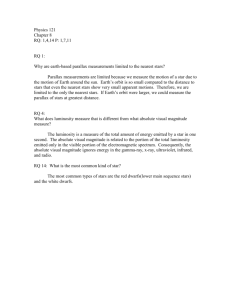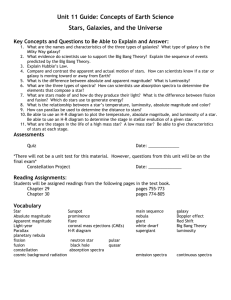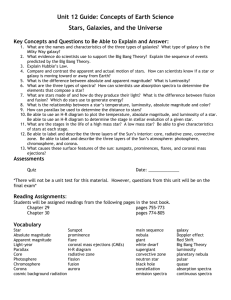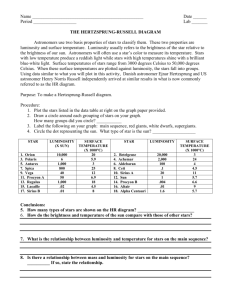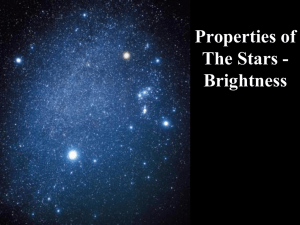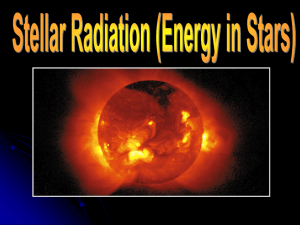properties of stars 2012
advertisement
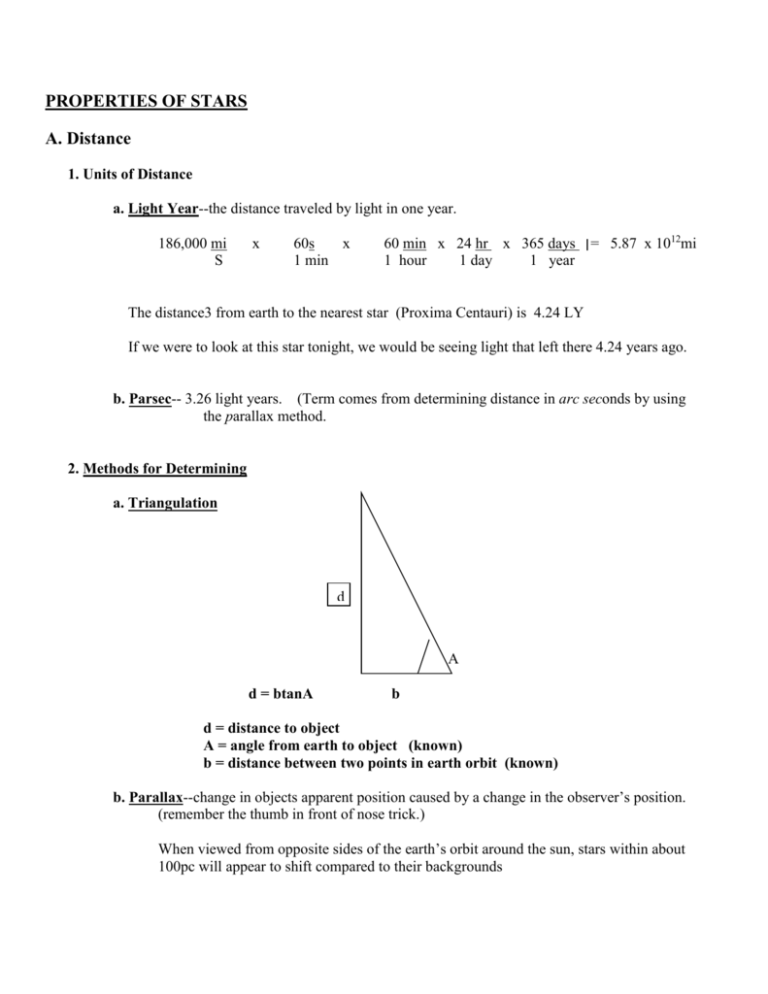
PROPERTIES OF STARS A. Distance 1. Units of Distance a. Light Year--the distance traveled by light in one year. 186,000 mi S x 60s x 1 min 60 min x 24 hr x 365 days 1 hour 1 day 1 year = 5.87 x 1012mi The distance3 from earth to the nearest star (Proxima Centauri) is 4.24 LY If we were to look at this star tonight, we would be seeing light that left there 4.24 years ago. b. Parsec-- 3.26 light years. (Term comes from determining distance in arc seconds by using the parallax method. 2. Methods for Determining a. Triangulation d A d = btanA b d = distance to object A = angle from earth to object (known) b = distance between two points in earth orbit (known) b. Parallax--change in objects apparent position caused by a change in the observer’s position. (remember the thumb in front of nose trick.) When viewed from opposite sides of the earth’s orbit around the sun, stars within about 100pc will appear to shift compared to their backgrounds When viewed from points one and two, the observed star will shift against its background. The closer it is, the more shift. Brightness Brightness of stars is a tricky concept, because there are a number of variables involved. For example, a star may look bright because it is very large, very close, or very hot. Luminosity--is the amount of energy an object radiates every second. (= absolute magnitude—see below) Apparent Brightness: How bright an objects looks to us, regardless of how much energy it produces. Inverse-square Law: relates an object's luminosity to its distance and apparent brightness. Since photons of light radiate outward in all directions from a spherical star, they are spread over a 2 larger area the farther they move from the star. This area is 4πd where is the distance traveled from the star. The law states: B = L___ 4πd2 where B is apparent brightness and L is luminosity So… if apparent brightness is determined (by using a light meter) and d is known (perhaps by parallax), luminosity can be determined. Apparent Magnitude: Hipparchus, in 150 B.C. classified stars by magnitude, with 1 being the brightest, and six being the dimmest. With the advent of technology, brighter objects are now noted by negative numbers. Each magnitude is 2.512 times brighter than that which follows it in the sequence. Absolute Magnitude: The magnitude a star WOULD have if it was 10pc from earth. (A measure of luminosity—true brightness. ) Temperature Color In general, red is cooler, blue is hotter (just like matter changes color on Earth with changing temperature.) Wien’s Law T = c/λm where T = temperature in kelvins, c is the speed of light, λm is the wavelength of maximum brightness. Spectral Classes There is a relationship between the temperature of a star and the appearance of the dark lines on its absorption spectrum. Star temperatures are classified, from hottest to coolest, by these letters: O B A F G K M (The non-alpha sequence is due to changes that took place as understanding of the relationship developed over time.) The classic mnemonic is “Oh, Be A Fine Girl/Guy--Kiss Me” ***** See class webpage, websites, “Stellar Spectroscopy Interactive”**** Mass Binary Stars are stars that orbit around each other. Motion between the stars depends on gravity, and gravity depends on mass. Therefore, motion can tell us something about the mass of the stars. The typical relationship looks like this ( you will recognize Kepler’s third Law) (m + M) p2 = a3 where m and M are the masses of the two stars, p is the period of revolution in years and a is the distance in AU’s There are a number of types of binary stars, but of special interest are ECLIPSING BINARIES When one passes in front of the other, the overall brightness drops. The length of the eclipse tells us something about the diameter of the stars. *****See class webpage (websites): “Binary Stars Interactive ”****** Variable Stars are those whose luminosity varies. A PULSATING variable is a star that is swelling and shrinking. As it swells, the same energy is spread over a larger area, the star cools and appears dimmer. (also, star cols because less pressure allows energy to escape) As it shrinks, it heats up (Gay-Lussac’s law--more pressure = higher temperature) and gives off more energy--appears brighter. A CEPHEID (sef ee id) VARIABLE is a pulsating star that has a luminosity up to a million times that of the sun. Cepheids are yellow giants with bright-dim-bright periods of one to 70 days. Since they are both bright and changing, they are easy to pick out, even over great distances. According to the Period-Luminosity Law, the length of the bright-dim-bright period and the luminosity of a star are directly related (Longer period, brighter star.) According to the Inverse Square Law (see in brightness section, above), if luminosity and apparent brightness are known, distance can be calculated.


